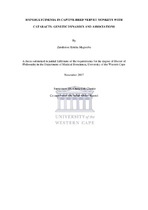| dc.contributor.advisor | Chauke, Chesa Gift | |
| dc.contributor.author | Magwebu, Zandisiwe Emilia | |
| dc.date.accessioned | 2018-08-02T11:25:32Z | |
| dc.date.available | 2018-08-31T22:10:06Z | |
| dc.date.issued | 2017 | |
| dc.identifier.uri | http://hdl.handle.net/11394/6181 | |
| dc.description | Philosophiae Doctor - PhD (Medical BioScience) | |
| dc.description.abstract | A small percentage (8%) of the captive-bred vervet monkeys (Chlorocebus aethiops)
maintained at Primate Unit and Delft Animal Centre (PUDAC) of the South African Medical
Research Council (SAMRC) were found to have high levels of glycine in their plasma (457-
795 ?mol/L) and cerebrospinal fluid (CSF) (7.5-12.7 ?mol/L). Additionally, these
hyperglycinemic monkeys developed cataracts, a condition which has been previously
characterized and reported in this specific colony of captive-bred vervet monkeys. This type of
association has never been reported in literature before, therefore, this study will be the first of
its kind to be investigated in non-human primates (NHPs). Nonketotic hyperglycinemia
(NKH), also known as glycine encephalopathy, is well characterised in humans. The symptoms
are exclusively neurological in nature, and clinically patients are diagnosed with abnormally
high glycine levels in plasma (normal <350 ?mol/L) and CSF (normal range 0-8). This
neurological disorder is transmitted in an autosomal recessive form and is mainly instigated by
a defective glycine cleavage system (GCS). In contrast to GCS, glycine transporter (GlyT1)
which regulates glycine concentration at synapses and valproate administration have been
associated with NKH. | |
| dc.language.iso | en | |
| dc.publisher | University of the Western Cape | |
| dc.title | Hyperglycinemia in captive-bred vervet monkeys with cataracts: genetic dynamics and associations | |
| dc.rights.holder | University of the Western Cape | |

